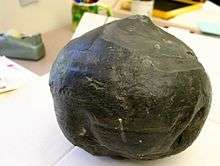Adolf Carl Noé
| Adolf Carl Noé | |
|---|---|
| Born |
Adolf Carl Noé von Archenegg October 28, 1873 Graz, Austria |
| Died | April 10, 1939 (aged 65) |
| Alma mater | University of Chicago |
| Known for | Coal ball and paleobotanical studies |
| Spouse | Mary Evelyn Cullatin |
Adolf Carl Noé (born Adolf Carl Noé von Archenegg; October 28, 1873 – April 10, 1939) was an Austrian-born paleobotanist. He is credited for identifying the first coal ball in the United States in 1922,[1] which renewed interest in them. He also developed a method of peeling coal balls using nitrocellulose.[2] Many of the paleobotanical materials owned by the University of Chicago's Walker Museum were provided by Noé, where he was also a curator of fossil plants.[3] He was also a research associate at the Field Museum of Natural History, where he assisted with their reconstruction of a Carboniferous forest.[4]
Education
From 1894 to 1897, Noé attended the University of Graz,[5] studying paleobotany under Constantin von Ettingshausen.[6] After Ettinghausen's death, Noé moved to Germany in 1897, having been transferred[7] to the University of Göttingen. He studied there until 1899, when he moved to the United States. During that year, Noé began his work at the University of Chicago.[5] He obtained a B. A. in 1900.[5] In 1901, he moved to California to teach German at Stanford University.[5] Four years later, in 1905, Noé earned a Ph.D. in Germanic Languages and Literatures.[8]
Near the end of World War I, Noé removed "von Archenegg" from his name to avoid anti-German sentiment.[4][5] Noé also stopped teaching German classes to research paleobotany, due to overstaffing and the public's disinterest in taking the German courses.[4]
Paleobotanical work

Noé became a geologist for the Allan and Garcia Coal Commission in the Soviet Union in 1927, ten years after the October Revolution. There, in the Donetz coal basin, Noé did work as a mining geologist.[9] In 1934, Noé became the Field Museum of Natural History's research associate, and assisted in the construction of a Pennsylvanian coal swamp there.[1]
Studies on coal balls
Coal balls in North America were found in Iowa coal seams since the 1890s,[9] although the connection to European coal balls was not made until Noé (whose coal ball was actually found by Gilbert Cady[1][9][10]) drew the parallel in 1922.[11] There was some disbelief over Noé's discovery.[9] For instance, in 1922, Noé was contacted by David White, who strongly believed that coal balls could not be found in North America.[9] Noé later managed to convince him otherwise by showing him a wheelbarrow full of Illinois coal balls, after which White never spoke to Noé again.[9]
Death
While translating the final chapter of a publication about coal in his office, Noé suffered a paralytic stroke on 11 March 1939.[12] He died on the morning of 10 April, five months before his planned retirement date of October 1939.[8]
Personal life
Noé married Mary Evelyn Cullatin in 1900. They had two daughters, Mary Helen Noé (who later married Nobel laureate Robert S. Mulliken) and Valerie Noé.[5]
References
- 1 2 3 Leighton & Peppers 2011
- ↑ Kraus 1939, p. 231
- ↑ Croneis 1939, p. 380
- 1 2 3 University of Chicago Library 2006, p. 4
- 1 2 3 4 5 6 Darrah & Lyons 1995, p. 175
- ↑ Andrews, Jr 1951, p. 441
- ↑ Andrews 1980, p. 237
- 1 2 Croneis 1939, p. 379
- 1 2 3 4 5 6 Darrah & Lyons 1995, p. 176
- ↑ Andrews, Jr 1951, p. 440
- ↑ Noé 1923, p. 385
- ↑ Darrah & Lyons 1995, p. 179
Bibliography
- Croneis, Carey (28 April 1939). "Adolf Carl Noé". Science, New Series (American Association for the Advancement of Science) 89 (2313): 379–380. JSTOR 1665330.
- Kraus, E. J. (September 1939). "Adolf Carl Noe". Botanical Gazette (University of Chicago Press) 101 (1): 231. doi:10.1086/334861. JSTOR 2472034.
- Leighton, Morris W.; Peppers, Russel A. (16 May 2011). "ISGS - Our Heritage - A Memorial: Adolf C. Noé". University of Illinois Board of Trustees. Archived from the original on 11 February 2012.
- Phillips, Tom L.; Pfefferkorn, Herman L.; Peppers, Russel A. (1973). "Development of Paleobotany in the Illinois Basin" (PDF). Illinois State Geological Survey. Archived from the original on 11 February 2012. Retrieved 15 September 2011.
- Darrah, William Culp; Lyons, Paul C. (1995). Historical Perspective of Early Twentieth Century Carboniferous Paleobotany in North America. United States of America: Geological Society of America. ISBN 0-8137-1185-1.
- "Guide to the Adolf Carl Noé Papers 1892-1939" (PDF). University of Chicago Library. 2006. Archived from the original on 11 February 2012. Retrieved 11 February 2012.
- Andrews, Jr, Henry N. (June 1951). "American Coal-Ball Floras". Botanical Review (Springer Science+Business Media on behalf of New York Botanical Garden Press) 17 (6): 431–469. doi:10.1007/BF02879039. JSTOR 4353462.
- Noé, Adolph C. (30 March 1923). "Coal Balls". Science (American Association for the Advancement of Science) 57 (1474): 385. doi:10.1126/science.57.1474.385. JSTOR 1648633. PMID 17748916.
- Andrews, Henry N. (1980). The Fossil Hunters: In Search of Ancient Plants. Cornell University Press. ISBN 0-8014-1248-X. OCLC 251684423.
|